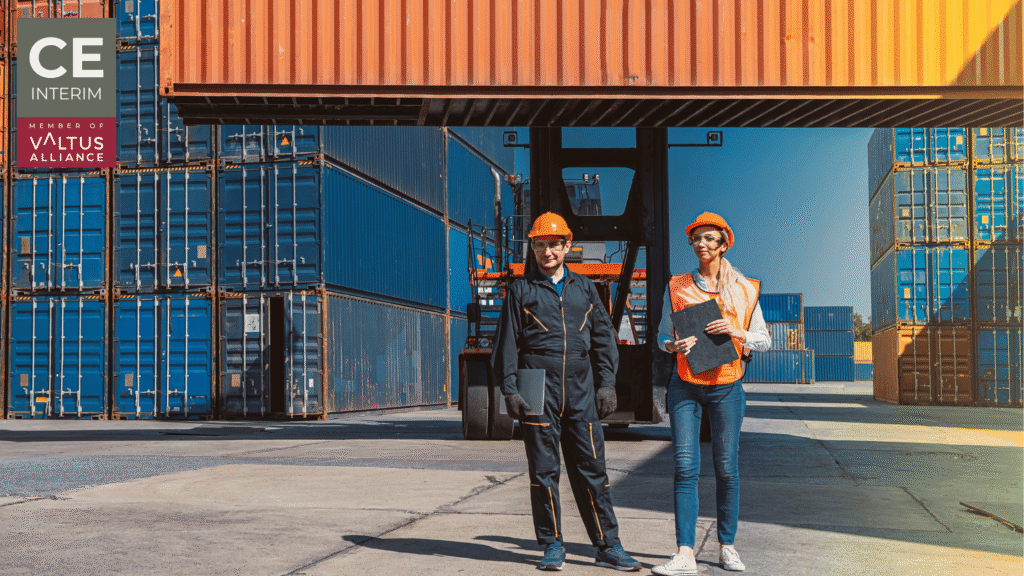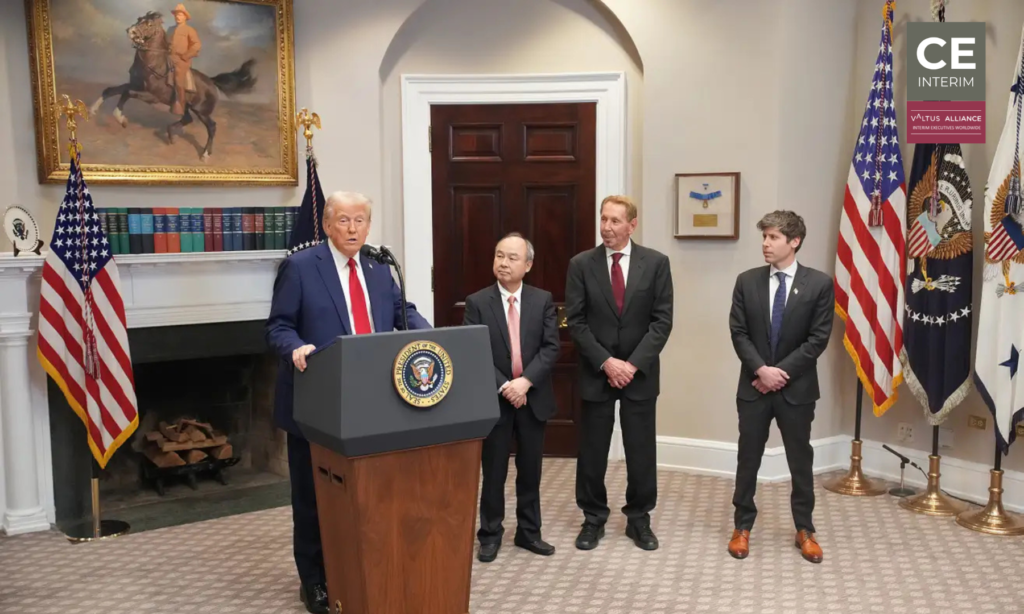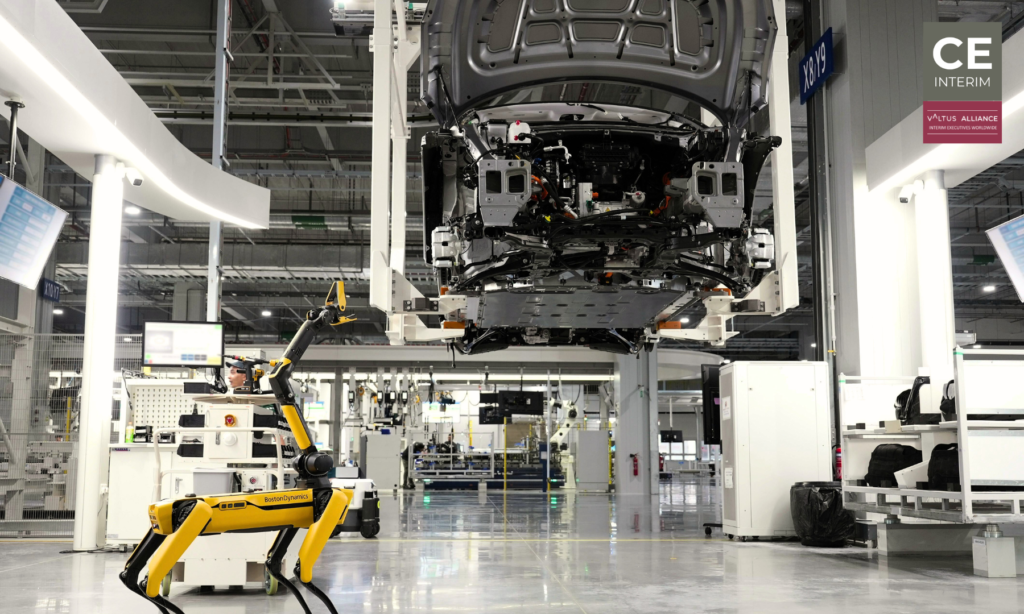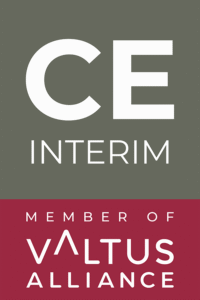Koridor VIII a Bulharsko: východná brána pre priemysel

Zistite, prečo sa vďaka koridoru VIII stáva Bulharsko logistickou veľmocou juhovýchodnej Európy a čo to znamená pre výrobcov a investorov.
Čo ženie Rheinmetall a technologických gigantov do Bulharska?

Rheinmetall, Liebherr a technologickí giganti expandujú v Bulharsku. Objavte skutočné hnacie sily, ktoré stoja za najrýchlejšie rastúcim priemyselným centrom v Európe.
$500B Iniciatíva Hviezdna brána: Výzvy pre európsky priemysel

Preskúmajte, ako iniciatíva $500B Stargate mení globálnu AI, jej výzvy pre európsky priemysel a stratégie na udržanie konkurencieschopnosti.
Prečo je východná Európa budúcnosťou premiestňovania výrobných závodov

Zistite, prečo je východná Európa ideálnou voľbou pre premiestnenie výrobného závodu vďaka nákladovej efektívnosti, kvalifikovanej pracovnej sile a blízkosti trhu.
Stratégie znižovania počtu výrobných závodov v západnej Európe

Účinné stratégie znižovania počtu výrobných závodov v západnej Európe vrátane premiestnenia, taktiky úspory nákladov a odbornej podpory dočasného riadenia.
IG Metall štrajkuje: Vplyv na európsky automobilový priemysel

Preskúmajte vplyv štrajkov IG Metall na európsky automobilový sektor a objavte stratégie pre stabilitu prostredníctvom relokácie v strednej a východnej Európe a na Balkáne.
Prečo je budúcnosť európskeho automobilového priemyslu v strednej a východnej Európe a na Balkáne

Zistite, prečo sú krajiny strednej a východnej Európy a Balkánu kľúčom k budúcnosti európskeho automobilového priemyslu, pretože ponúkajú nákladové výhody a udržateľnosť v sektore elektrických vozidiel.
Navigácia v neistote: Expanzia do strednej a východnej Európy s výrobnou stopou China plus One pre nákladovo efektívnu výrobu

Nemáte dosť času na prečítanie celého článku? Vypočujte si zhrnutie za 2 minúty. Čína, ktorá bola dlhé roky svetovým centrom výroby, už nie je taká slávna. Región zápasí s novodobými výzvami, ktoré ho robia menej predvídateľným a nákladovo efektívnym. Ak sa vaša firma spolieha pri výrobe výlučne na Čínu, zložitá sieť spriadaná rastúcimi nákladmi, geopolitickou neistotou a nestálosťou trhu jej prinesie zánik. Spoločnosti sa zaoberajú minimalizáciou rizík a znižovaním nákladov. Stratégia Čína plus jedna sa teší prudkému nárastu popularity. Diverzifikuje výrobu medzi ázijské centrum a iné regióny. Viac spoločností sa pozerá na strednú a východnú Európu (SVE) alebo Balkán ako na ideálne miesto pre stratégiu "Plus One". Vďaka blízkosti k európskym trhom, kvalifikovanej pracovnej sile a nižším prevádzkovým nákladom sa región SVE stáva kľúčovým hráčom v globálnej výrobe. Pochopenie úpadku Číny ako hlavného výrobného centra Čína postavila svoju výrobnú pevnosť na troch kľúčových pilieroch - škálovateľnosti, nákladovej efektívnosti a infraštruktúre. Poskytuje rozsiahle výrobné kapacity za primerané náklady, ktorým sa môže rovnať len niekoľko ďalších krajín. Má rozsiahlu priemyselnú základňu so schopnosťou rýchlo, efektívne a vo veľkom rozsahu vyrábať veľké objemy. Relatívne nižšie náklady na pracovnú silu v porovnaní so Západom sú ďalšou výhodou napriek globálnemu nárastu miezd o 70% v poslednom desaťročí (McKinsey). Okrem toho má prvotriednu infraštruktúru s prístavmi, železnicami a továrňami, ktoré sú určené na podporu tradičnej veľkovýroby a efektívnej globálnej logistiky. Vďaka týmto faktorom je Čína vhodnou voľbou pre veľkosériovú výrobu. Dominantná pevnosť však začína mať trhliny. Logistické náklady rastú (podľa Svetovej banky za posledné roky o 20%), obchodná vojna medzi USA a Čínou vytvára politickú nestabilitu a udalosti ako pandémia COVID-19 a havária Suezského prieplavu odhalili zraniteľnosť globálnych dodávateľských reťazcov. Prečo je ideálny čas na voľbu stratégie Čína plus jeden? Uvedené faktory sa zhoršujú v dôsledku nestabilnej globálnej ekonomiky, kde regulačné zmeny alebo obchodné sankcie môžu vážne narušiť výrobné a distribučné siete. Podniky sú pod tlakom, aby mysleli aj mimo Číny a preskúmali možnosti diverzifikácie. Stratégia Čína plus jeden sa javí ako ideálny materiál na odstránenie trhlín. Umožňuje spoločnostiam zachovať prevádzku v Číne a zároveň založiť výrobné závody v iných regiónoch, ako je stredná a východná Európa alebo Balkán. Tieto alternatívne destinácie poskytujú kombináciu úspory nákladov, blízkosti trhu a politickej stability. Je to najlepší prístup v súčasnom období globálnych hospodárskych otrasov. Vznik strednej a východnej Európy/balkánskych krajín ako ideálnej destinácie pre plán "Čína plus jeden" Stredná a východná Európa predstavuje atraktívnu možnosť pre podniky, ktoré chcú vytvoriť sekundárnu výrobnú stopu. Tento región má významné príležitosti na úsporu nákladov vďaka množstvu kvalifikovanej pracovnej sily, ktorá je k dispozícii za relatívne nižšie mzdy ako na Západe, bližšej vzdialenosti ku kľúčovým trhom, zjednodušeniu dodávateľských reťazcov a vynikajúcim regulačným normám. Veľké značky ako Bosch, Mercedes-Benz a Samsung už rozšírili výrobu do týchto regiónov. Rovnakou cestou diverzifikácie sa chcú vydať aj ďalšie podniky, a to vďaka viacerým výhodám. Geografická blízkosť a kratšie dodacie lehoty Preprava tovaru z Číny do Európy zvyčajne trvá 30 až 45 dní prostredníctvom námornej prepravy. Naproti tomu preprava tovaru z krajiny SVE môže trvať 1 - 3 dni cestnou alebo železničnou dopravou, čo umožňuje spoločnostiam zaviesť efektívnejšie dodávateľské reťazce just-in-time. Keď sa skráti čas prepravy, ušetria sa peniaze, zrýchlia sa dodávky a vy môžete rýchlo reagovať na požiadavky trhu. Nižšie náklady na pracovnú silu bez obetovania zručností Zatiaľ čo náklady na pracovnú silu v Číne zostávajú konkurencieschopné, krajiny ako Maďarsko, Rumunsko a Bulharsko ponúkajú ceny práce, ktoré sú o 40-60% nižšie ako v západnej Európe. Tieto krajiny majú tiež vysokokvalifikovanú pracovnú silu, najmä pre automobilový priemysel, elektroniku a strojárstvo. To z nich robí atraktívnu destináciu pre podniky, ktoré potrebujú kvalifikovanú pracovnú silu za nominálnu mzdu. Investície do infraštruktúry a technologického pokroku Krajiny strednej a východnej Európy výrazne modernizovali svoju infraštruktúru, čím sa stali atraktívnejšími pre globálnych výrobcov. Napríklad Česká republika sa podľa Svetovej banky radí medzi 30 najlepších krajín na svete v oblasti logistiky. Krajiny v regióne vo veľkom investujú do inteligentných tovární, automatizácie a možností Priemyslu 4.0, čo podnikom poskytuje prístup k najmodernejším výrobným technológiám bez vysokej ceny, ktorá sa spája so západnou Európou. Zosúladenie právnych predpisov s EÚ v oblasti riadenia zhody Krajiny strednej a východnej Európy a Balkánu sa prispôsobujú predpisom Európskej únie (EÚ). Tým sa zabezpečuje, že spoločnosti dodržiavajú prísne environmentálne, pracovné a bezpečnostné normy, čím sa znižuje riziko nákladných právnych sporov alebo sankcií za nedodržiavanie predpisov, ktoré by mohli vzniknúť pri pôsobení v regiónoch s menej prísnymi normami. Jednotný trh EÚ tiež umožňuje ľahší prístup k cezhraničnému obchodu, čím sa zjednodušujú operácie pre podniky, ktoré obsluhujú viacero európskych krajín. Politická stabilita sľubujúca dlhodobý rast Politická stabilita pomáha budovať základy úspešného výrobného podniku. Krajiny strednej a východnej Európy a Balkánu ako súčasť EÚ ponúkajú priaznivé, stabilné a politické podnikateľské prostredie. Spoločnosti môžu s dôverou plánovať svoje investície. To sa však nedá povedať o mnohých ázijských a afrických krajinách. Ako Čína plus stredná a východná Európa/balkánske krajiny zefektívňujú výrobu z hľadiska nákladov? Kombinácia nižších nákladov na pracovnú silu, kratších prepravných vzdialeností a lepšej infraštruktúry robí výrobu v strednej a východnej Európe nákladovo efektívnejšou ako udržiavanie prevádzky len v Číne. Tento krok tiež umožňuje podnikom využívať výhody znížených ciel a daňových stimulov, ako aj menšie oneskorenia v dodávateľskom reťazci a nižšie náklady na dopravu. Vzhľadom na to, že náklady na nákladnú dopravu v posledných rokoch vzrástli o viac ako 300% (podľa agentúry Bloomberg), zníženie závislosti od diaľkovej prepravy z Ázie do Európy môže priniesť významné úspory nákladov. Podniky si môžu zachovať pružnosť tým, že majú možnosť meniť miesta výroby na základe nákladov, dopytu a politického vývoja. Táto flexibilita je kľúčová pre zachovanie nákladovej efektívnosti v dlhodobom horizonte a udržanie konkurencieschopnosti. Ako správne realizovať stratégiu Čína plus jeden? Realizácia úspešnej stratégie China Plus One (SVE/Balkán) si vyžaduje hlboké pochopenie a plánovanie jedinečných výhod Číny aj SVE. Pri tvorbe stratégie sa zamerajte na celkové logistické náklady, miestne stimuly, možnosti pracovnej sily, flexibilitu dodávateľského reťazca a ďalšie dôležité faktory. Keď je váš plán pripravený, môžete
Za hranicami: Využitie stratégie "Čína plus jeden" na zníženie nákladov a udržanie ziskovosti v EÚ

Nemáte dosť času na prečítanie celého článku? Vypočujte si zhrnutie za 2 minúty. Čína sa stala svetovým výrobným centrom vďaka rozsiahlym výhodám. Nedávne globálne udalosti však odhalili zraniteľnosť spoliehania sa na túto krajinu ako na výrobnú základňu. Musíte mať záložný plán pre prípad, že sa situácia zhorší. Rastú náklady na logistiku, dochádza k obchodným vojnám, pretrváva politická nestabilita a spotrebitelia sú čoraz skeptickejší. To prinútilo podniky diverzifikovať výrobné siete - čo viedlo k vzniku "stratégie Čína plus jedna". Ide o inteligentný prístup, ktorý umožňuje spoločnostiam zachovať si svoj čínsky výrobný závod a zároveň kombinovať jeho výhody s výrobou na strategických miestach, ako je stredná a východná Európa (SVE) alebo Balkán. Tým sa výrazne minimalizujú riziká a zvyšuje odolnosť pri zachovaní ziskovosti a konkurencieschopnosti. Ponorme sa hlbšie do tohto taktického prístupu, aby sme zistili, či je to pre vás tá správna stratégia. Výhody a obmedzenia Číny ako výrobného uzla Na začiatok musíte pochopiť výhody a výzvy, ktoré prináša existencia výrobného uzla len v Číne: Kľúčové výhody: Obrovská výrobná kapacita: Čína stále ponúka neuveriteľnú škálovateľnosť. Ak je cieľom vašej spoločnosti veľkosériová výroba, potom je to veľmi výhodné miesto. Nízke náklady na pracovnú silu: Podľa spoločnosti McKinsey síce náklady na pracovnú silu v Číne za posledné desaťročie výrazne vzrástli - až o 70% -, ale pre mnohé odvetvia zostávajú konkurencieschopné. Efektívnosť infraštruktúry a dodávateľského reťazca: Čína má dobre rozvinutú infraštruktúru, ktorá podporuje jej robustné dodávateľské reťazce, takže pre iné regióny je ťažké napodobniť jej logistickú efektívnosť. Výzvy: Rastúce logistické náklady: Náklady na dopravu z Číny do Európy sa v posledných rokoch zvýšili o viac ako 300%, ako uvádza agentúra Bloomberg. Dôvodom sú rastúce ceny palív, úzke miesta v globálnom dodávateľskom reťazci a nedostatok kontajnerov. To značne zaťažuje ziskovosť. Embargá a obchodné vojny: Prebiehajúca obchodná vojna medzi USA a Čínou a ďalšie geopolitické napätia spôsobili, že podniky prehodnotili svoju nadmernú závislosť od Číny, čo viedlo k zvýšeniu ciel, narušeniu dodávateľských reťazcov a neistote. Politická nestabilita: Vzhľadom na často sa meniace politiky, ako sú embargá a obchodné obmedzenia, čelia spoločnosti závislé výlučne od čínskej výroby značným rizikám pri udržiavaní stabilných dodávateľských reťazcov. Prečo sa stratégia Čína plus jedna stala potrebou tejto hodiny? Diverzifikácia mimo Číny už nie je len možnosťou, ale nevyhnutnosťou vzhľadom na hrozivé riziká. Stratégia China Plus One zabraňuje tomu, aby ste sa príliš spoliehali na jediné miesto výroby, a ponúka ochranu pred globálnymi neistotami. Tu sú 3 kľúčové dôvody, prečo je to správny prístup: Zmiernenie rizík: Spoločnosti využívajúce stratégiu China Plus One znižujú svoju expozíciu voči obchodným vojnám, clám a iným ekonomickým a geopolitickým rizikám. Just-in-time logistika: Výroba bližšie k Európe umožňuje spoločnostiam efektívnejšie dodržiavať zásady just-in-time. Tovar zasielaný z Číny sa prepravuje 30 až 45 dní, zatiaľ čo vnútroeurópske zásielky dorazia len za 1 až 3 dni. Všimnite si tento rozdiel. Náklady na prepravu: Rastúce ceny pohonných hmôt a dopravné prekážky spôsobujú, že diaľková doprava z Číny je neúnosne drahá. Získajte preto výrobu v blízkosti svojho domova a znížte náklady na prepravu. Prečo si vybrať strednú a východnú Európu (SVE) alebo Balkán pre stratégiu Plus One? Stredná a východná Európa a Balkán sa stali novými destináciami pre spoločnosti, ktoré chcú presunúť svoju výrobnú základňu alebo investovať do nového výrobného závodu. Krajiny ako Rumunsko, Maďarsko, Poľsko a ďalšie majú taktické výhody, ako je blízkosť trhu, množstvo kvalifikovaných talentov, možnosti úspory nákladov, skvelé zosúladenie právnych predpisov a ďalšie. Geografická blízkosť a znížené náklady na dopravu Krajiny strednej a východnej Európy sú blízko kľúčových európskych trhov a Vďaka kratšej vzdialenosti sú aj dodacie lehoty rýchlejšie, časy realizácie kratšie a reakcia na trhu rýchlejšia. Spoločnosti môžu znížiť prepravné náklady na polovicu v porovnaní s prepravou vecí z Číny. Nižšie náklady na pracovnú silu v porovnaní so západnou Európou Podľa OECD sú náklady na pracovnú silu v krajinách strednej a východnej Európy a na Balkáne o 40 až 60% nižšie ako v západnej Európe napriek tomu, že majú rovnako kvalifikovanú pracovnú silu. To pomáha spoločnostiam šetriť peniaze bez toho, aby museli bojovať s logistickými a geopolitickými problémami ázijských krajín. Infraštruktúra a logistická sieť Krajiny ako Poľsko a Česká republika v poslednom desaťročí významne investovali do infraštruktúry. To z nich robí vynikajúcu destináciu pre výrobné prevádzky. Svetová banka zaradila Poľsko medzi 25 najlepších krajín na svete v oblasti logistiky. Politická stabilita Mnohé krajiny strednej a východnej Európy a Balkánu sú členmi Európskej únie. To zabezpečuje zosúladenie právnych predpisov s normami EÚ, čo znižuje právne riziká a riziká súvisiace s dodržiavaním predpisov. Politická stabilita v týchto krajinách je v kontraste s nepredvídateľnejším prostredím v niektorých iných nízkonákladových výrobných destináciách, ako je juhovýchodná Ázia. Porovnanie krajín strednej a východnej Európy a Balkánu s inými nízkonákladovými výrobnými destináciami Porovnajme teraz strategické lokality, ako je stredná a východná Európa a Balkán, s tradičnými výrobnými centrami, ako je Ázia (Vietnam, Bangladéš atď.), Latinská Amerika a Afrika. Ázijské krajiny ponúkajú lacnú pracovnú silu, ale sú tu zásadné problémy s kvalifikáciou a časy prepravy sú príliš dlhé. Medzitým Latinská Amerika môže byť ideálnym riešením pre spoločnosti so sídlom v USA, ale pre európske firmy stále predstavuje logistické výzvy a regulačné problémy. A nakoniec, Afrika je pre spoločnosti rozvíjajúcim sa trhom, ale nedostatočne rozvinutá infraštruktúra, politická nestabilita a nedostatok kvalifikovanej pracovnej sily odrádzajú výrobné spoločnosti. Kľúčové výhody stratégie China Plus CEE/Balkans pre európske podniky Vďaka výrobnej stratégii China Plus CEE/Balkans môžu spoločnosti získať prístup k rozsiahlemu zoznamu výhod: Znížená závislosť na Číne: Keď diverzifikujete mimo Číny, rozložíte koncentrované riziká a vaše podnikanie sa nezastaví kvôli problémom v jednom regióne. Nákladovo efektívna logistika: Keď vyrábate v strednej a východnej Európe alebo na Balkáne, náklady na dopravu sú o 30-40% nižšie ako v Číne. To tiež zvyšuje zisky a zároveň skracuje dodacie lehoty. Odolnosť a flexibilita: Diverzifikáciou výroby medzi Čínou a Európou môžu spoločnosti ľahko meniť prevádzky na základe dopytu na trhu alebo geopolitického vývoja, čo ponúka väčšiu prevádzkovú flexibilitu. Zosúladenie právnych predpisov s normami EÚ: Výroba v strednej a východnej Európe zabezpečuje úplný súlad s environmentálnymi, pracovnými a bezpečnostnými predpismi EÚ, čím sa znižuje riziko pokút, právnych sporov a porušenia predpisov. Ako implementovať účinný plán Čína plus jeden? Implementácia efektívneho plánu China Plus One nie je hračka. Musíte
Od krízy k príležitosti: Ako môže stratégia Čína plus jeden ochrániť váš dodávateľský reťazec a zvýšiť ziskovosť

Nemáte dosť času na prečítanie celého článku? Vypočujte si zhrnutie za 2 minúty. Prebiehajúce udalosti, ako sú obchodné vojny, rastúce ceny energií a geopolitické napätie, spôsobili, že globálne podnikateľské prostredie je nepredvídateľné. Je normálne, že spoločnosti uprostred chaosu zápasia s problémami. Existuje však jeden krok, ktorý výrobným podnikom prináša úľavu. Je to stratégia Čína plus jeden. Ide v podstate o model diverzifikácie, v rámci ktorého spoločnosti presúvajú časť svojej výroby mimo Číny, najlepšie do strategických lokalít, ako je stredná a východná Európa (SVE) alebo Balkán, aby využili výhody týchto vznikajúcich výrobných centier. Predtým podniky skúmali tento plán ako spôsob, ako zmierniť riziká spojené so spoliehaním sa na jedno výrobné miesto. V súčasnosti sa však čoraz častejšie uplatňuje s cieľom čeliť nestabilnému podnikateľskému prostrediu v Číne, zvýšiť ziskovosť a vybudovať odolnosť dodávateľského reťazca. Od krízy k príležitosti, poďme odhaliť, ako novodobý prístup China Plus One transformuje výrobné podniky. Skúmanie krízy globálnych dodávateľských reťazcov Riadenie globálnych dodávateľských reťazcov je náročné. Keď dôjde k udalostiam, ako je pandémia COVID-19, nedostatok kontajnerov a havária Suezského prieplavu, ste vystavení zraniteľnosti dlhších dodávateľských reťazcov. Spoločnosti sú znepokojené viac ako kedykoľvek predtým. Výlučná závislosť od Číny vášmu výrobnému podniku nepomôže. Určite bude čeliť oneskoreniu výroby, nedostatku materiálu a rastúcim logistickým nákladom. To povedie k neuspokojeným požiadavkám trhu a premárneným príležitostiam. Obchodná vojna, najmä medzi USA a Čínou, situáciu ešte zhorší. Zavádza clá a vývozné obmedzenia, ktoré zvyšujú výrobné náklady. Ďalším znepokojujúcim faktorom je nárast prevádzkových nákladov. V Číne, ale aj v západnej Európe rastú náklady na pracovnú silu a energiu. To výrazne znižuje ziskovosť, ak sa vaša spoločnosť spolieha na model výroby z jedného zdroja. Premena krízy na príležitosť pomocou stratégie China Plus One Moderné výrobné spoločnosti sa prispôsobujú a menia krízu na príležitosť pomocou inteligentnej stratégie China Plus One. Namiesto toho, aby bojovali s narušeniami, využívajú ich na vybudovanie silných dodávateľských reťazcov a zvýšenie ziskovosti prevádzky. Chcete vedieť, prečo diverzifikácia výroby mimo Číny pomáha vašim výrobným podnikom? Poďme to zistiť: Zmiernenie rizika prostredníctvom diverzifikácie dodávateľského reťazca Keď vyrábate v Číne aj v Poľsku, môžete meniť výrobu na základe požiadaviek trhu alebo narušení. Stratégia China Plus One rozdeľuje výrobu do viacerých krajín a zabraňuje závislosti od jedného zdroja. Optimalizácia nákladov a zvýšenie ziskových marží Krajiny strednej a východnej Európy a Balkánu majú rozsiahle nákladové výhody. Poskytujú kvalifikovanú pracovnú silu za relatívne nižšie mzdy, lepšiu infraštruktúru s nominálnymi investíciami, vládne stimuly a daňové dotácie a kratšie dodávateľské reťazce. To je skvelé pre zvýšenie ziskovosti. Prístup na rozvíjajúce sa trhy Metóda Čína plus jeden sa neobmedzuje len na presun prevádzkových základní. Umožňuje vašej spoločnosti preniknúť aj na nevyužité trhy. Môžete napríklad expandovať do strednej a východnej Európy a na Balkán a získať tak prístup k novým spotrebiteľským základniam, miestnym dodávateľom a vládnym stimulom. Je to istá príležitosť na rast. Budovanie udržateľných a kompatibilných prevádzok Keď presuniete výrobu do regiónov, ktoré sú v súlade s environmentálnymi, sociálnymi a správnymi normami, zlepšíte tým udržateľnosť svojej spoločnosti. Krajiny strednej a východnej Európy a Balkánu sú často cieľom diverzifikácie, pretože sú v súlade s predpismi Európskej únie (EÚ). Prináša to dve hlavné výhody - bezproblémové riadenie dodržiavania predpisov a lepšiu povesť značky. Prečo sú stredná a východná Európa a Balkán ideálnymi destináciami pre túto stratégiu? Stredná a východná Európa a Balkán sa stávajú dvoma ideálnymi destináciami pre spoločnosti, ktoré diverzifikujú výrobu mimo Číny a v rámci Európy. Pochopme, prečo výrobné spoločnosti sledujú tieto krajiny s cieľom zlepšiť svoju ziskovosť a dodávateľské reťazce: Stredná a východná Európa (SVE): Krajiny SVE, ako sú Poľsko, Maďarsko, Rumunsko, Slovensko a Česká republika, sa menia na výrobné veľmoci. Tu je návod, ako na to: Balkán Krajiny ako Srbsko, Severné Macedónsko a Bosna a Hercegovina čoraz viac priťahujú zahraničné investície z viacerých dôvodov: Ako stratégia Čína plus jeden zvyšuje ziskovosť Model Čína plus jeden sa ukazuje ako neuveriteľný spôsob, ako zvýšiť ziskovosť výrobných spoločností, najmä tých z Európy. Poďme si ho podrobne vysvetliť: Zníženie prevádzkových nákladov Spoločnosti, ktoré presúvajú výrobu do strednej a východnej Európy a na Balkán, môžu znížiť mzdové a prevádzkové náklady pri zachovaní kvality výrobkov. Napríklad výrobcovia automobilov, ktorí presúvajú svoje prevádzky do Maďarska alebo Rumunska, profitujú z lacnejšej výroby bez toho, aby sa znížila produkcia. Menej spálených zdrojov, viac peňazí. Kratšie dodacie lehoty a väčšia pružnosť trhu Keď vyrábate v blízkosti európskych trhov, môžete minimalizovať riziko výpadkov zásob a rýchlejšie sa dostať na trh. Vaša spoločnosť sa tak môže prispôsobiť výkyvom dopytu na trhu. Táto pružnosť je nevyhnutná v rýchlo sa meniacich odvetviach, ako je elektronika a spotrebný tovar. Vládne stimuly a daňové úľavy Mnohé krajiny strednej a východnej Európy a Balkánu ponúkajú daňové úľavy, dotácie na pôdu a stimuly na výskum a vývoj. Poľské špeciálne ekonomické zóny a srbské programy priamych zahraničných investícií umožňujú spoločnostiam maximalizovať zisky znížením zriaďovacích nákladov. Kroky na efektívnu implementáciu stratégie China Plus One Teraz, keď ste sa rozhodli pokračovať v stratégii China Plus One s cieľom diverzifikovať výrobu a zvýšiť ziskovosť a odolnosť dodávateľského reťazca, poďme pochopiť, ako postupovať. Tu je niekoľko krokov, ktoré budete musieť vykonať: Ak to všetko znie skľučujúco a komplikovane, pomôžeme vám ľahko vybudovať alebo premiestniť továreň a získať maximálnu výhodu bez toho, aby ste sa zapotili. Záverečné stanovisko Stratégia Čína plus jedna je skvelá. Jej kombinácia s diverzifikáciou do strednej a východnej Európy alebo na Balkán z nej robí "to najlepšie pre podnikanie". Výrobné podniky môžu potlačiť nepredvídateľnosť a bojovať s rizikami skôr, ako ich premôžu. A čo je najdôležitejšie, podniky môžu zvýšiť ziskovosť a vybudovať dodávateľské reťazce odolné ako titán. Tieto regióny poskytujú neuveriteľnú kombináciu nízkych nákladov, kvalifikovanej pracovnej sily a prístupu na trh pre dlhodobý rast podnikov, pričom sa stále prispôsobujú normám EÚ. Čo ešte potrebuje výrobný podnik v dnešnom konkurenčnom svete? Preto nestrácajte viac času a pripravte sa na sťahovanie hneď teraz. Bojujete so zložitými prevádzkovými výzvami? Spoločnosť CE Interim, ktorá je súčasťou globálnej siete Valtus Alliance, je tu, aby poskytla odbornú podporu dočasného manažmentu pri investíciách na zelenej lúke, premiestňovaní závodu, dosahovaní prevádzkovej dokonalosti a


